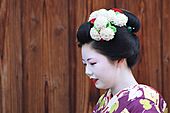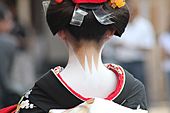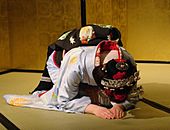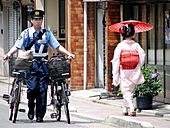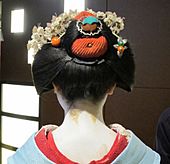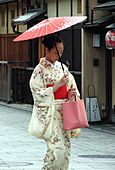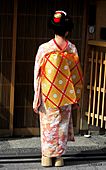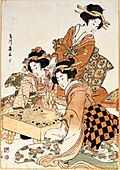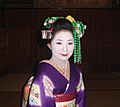Geisha facts for kids
Quick facts for kids Geisha |
|||||
|---|---|---|---|---|---|
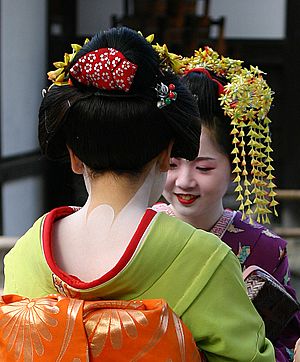 |
|||||
| Japanese name | |||||
| Kanji | 芸者 | ||||
|
|||||
Geisha (芸者) or geigi (芸妓) are traditional Japanese entertainers. They are very skilled in different Japanese arts. This includes playing classical Japanese music, dancing, and poetry. The word "geisha" comes from two Japanese words: gei meaning "art" and sha meaning "person who does." So, a geisha is an "artist." Geisha are highly respected, and it takes a lot of effort to become one.
Another common name for geisha is Geiko (芸子). This word is used in Kyoto, where the geisha tradition is very old and strong. Becoming a professional geiko in Kyoto usually takes about five years of training.
Young women who are training to become geisha are called "maiko" (舞子). This name means "dancing child." Maiko wear white make-up and kimonos with many bright colors. Full geisha wear simpler kimonos. They only use white make-up for special events.
Geisha also live in other cities, but they might be a bit different. In Tokyo, becoming a full geisha takes less time, usually six months to a year. Tokyo geisha apprentices are called "han'gyoku" (半玉), meaning "half-jewel," or "o-shaku" (御酌), meaning "one who serves drinks." Tokyo geisha are usually older than Kyoto geiko.
Modern geisha often live in traditional geisha houses called "okiya" (置屋). These houses are found in special neighborhoods called "hanamachi" (花街), or "flower towns." However, many older, successful geisha have their own homes. The elegant world of geisha is known as "karyūkai" (花柳界), which means "the flower and willow world." A famous geisha, Mineko Iwasaki, explained this name. She said a geisha is like a flower, beautiful in her own way. She is also like a willow tree, graceful, flexible, and strong.
Geisha are seen as important cultural icons of Japan.
Contents
Geisha in Modern Japan
Today, most geisha activities happen in the hanamachi areas of Kyoto and Tokyo. You will rarely see them outside these special districts. In the 1920s, there were over 80,000 geisha in Japan. Now, there are far fewer, mainly because Western culture has become more popular. The exact number is not known, but it's thought to be between 1,000 and 2,000. Many women who appear as geisha for tourists are actually actresses dressed up as maiko.
Young women who want to become geisha usually start their training after finishing junior high school, high school, or even college. Many begin their careers as adults. Geisha still learn to play traditional Japanese musical instruments. These include the shamisen, shakuhachi (a bamboo flute), and drums. They also learn traditional songs, Japanese dance, tea ceremony, literature, and poetry. By watching older geisha, apprentices also learn how to dress, apply make-up, and interact with clients.
Geisha are often hired for parties and gatherings. These usually take place at tea houses or traditional Japanese restaurants. Their time is measured by how long an incense stick burns. This payment is called "senkōdai" (線香代), or "incense stick fee," or "gyokudai" (玉代), "jewel fee." In Kyoto, they use the terms "ohana" (お花) and "hanadai" (花代), meaning "flower fees." Clients hire geisha through the Geisha Union Office. This office manages the geisha's schedule and appointments for both entertaining and training.
How Geisha Train
In the past, geisha training started at a very young age. Some girls were sold to become geisha, but this was not common in good hanamachi. Daughters of geisha often became geisha themselves.
The first part of training is called "shikomi". In the past, new girls worked as maids in the okiya (tea house). The work was hard, meant to test the new girls. The youngest shikomi had to wait late at night for the older geisha to return from work. This could be as late as two or three in the morning. During this time, shikomi also went to classes at the hanamachi's geisha school. Today, this stage still exists, but it is not as difficult. Now, shikomi get used to the traditions and clothing of the "flower and willow world."
Once an apprentice became skilled in the geisha arts, she took a difficult dance test. If she passed, she moved to the second stage: "minarai". Minarai no longer did housework. This stage is much shorter today, lasting only about a month. Minarai learn by watching. They go to banquets and dances with geisha. They don't perform, but they sit, watch, and learn from their onee-san (older sisters). Their kimonos are very fancy, even more so than a maiko's. This helps them stand out and "do the talking" for them.
After a short time, the third and most famous stage begins: "maiko". Maiko are apprentice geisha, and this stage can last for years. Maiko learn from their senior geisha. They follow them to every performance. The "onee-san/imoto-san" (older sister/younger sister) relationship is very important. The onee-san teaches her maiko everything about working in the hanamachi. She teaches her how to serve tea, play the shamisen, and dance. She also teaches about the art of Iki (see below). Maiko must wear heavy white make-up and elaborate hairstyles. Their lips are almost always painted. Their kimonos and obi (sashes) have brighter colors and richer embroidery than those of full geisha. Like minarai, maiko do not charge as much money for parties as full geisha.
After about six months in Tokyo or five years in Kyoto, the maiko becomes a full geisha. She then charges the full price for her time. Geisha wear kimonos with fewer colors. They only use make-up for work or dance. This is because they are more mature than a maiko, and their simpler style shows their natural beauty. Geisha continue in this role until they retire.
The Art of Geisha and Iki
Becoming a geisha requires a lot of discipline. A geisha believes she must be a work of art herself. They work every day to improve in everything they do. A geisha's movements, how she walks, sits, and talks are all very important. Geisha are always "geisha," even when they are not working or are at home. An example of this dedication is the old custom of kangeiko ("lessons in the cold"). Until the early 1920s, apprentice geisha would put their hands in icy water. Then, they would go outside in cold weather to practice playing the shamisen.
Picture gallery
- Different pictures
-
Two geikos playing the shamisen and the shinobue.
Related pages
Images for kids
See also
 In Spanish: Geisha para niños
In Spanish: Geisha para niños




